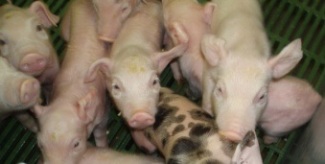Genetic Studies of Influenza A Viruses Circulating in Pigs in Spain

The complete genome sequences of some swine influenza viruses circulating in Spain in different outbreaks suggest that these outbreaks could be due to the persistency of some viruses in determinate Spanish regions.
Researchers at CReSA have studied the genetic characterization of influenza A viruses circulating in pigs and isolated in north-east Spain during the 2006–2007 period. Phylogenetic analysis revealed that they belonged to the lineages "Avian-Like" H1N1, "Human-Like" H3N2, and "Human-Like" H1N2, showing tight relationships with early or contemporary strains described in Europe. Notably, one virus of the H1N2 subtype showed genetic and antigenic divergence with the European contemporary strains or vaccinal strains of the same subtype, suggesting that some local and divergent clusters of the virus may pass unnoticed in routinary subtyping. Finally, analysis on the entire pattern of genome segments suggested that a second reassortment event could have influenced the evolution of the divergent H1N2 strain.
Swine influenza virus (SwIV) is one of the most important pathogens involved in the swine respiratory disease complex. Recent serological surveys showed a high prevalence of swine influenza strains belonging to the H1N1, H1N2 and H3N2 subtypes circulating in pigs in Spain. However, little is known about their genome sequence.
"The genetic characteristics of some SwIV circulating in Spain during the period 2006–2007 showed some clues about cross-boundary introduction or reintroduction of SwIV in Spanish pig herds, being a common event in that period. However, this study also suggests that SwIV outbreaks could be due to the persistency of some viruses in determinate Spanish regions", says Dr. Maria Montoya, leading scientist of the study.
Moreover, Dr. Montoya emphasizes that the factors leading to this mixed situation (introduction-reintroduction and persistency of SwIV strains) should be investigated in depth, as they may help to understand the epidemiology of SwIV after pandemic outbreaks. Additionally, it may help establishing control plans of the disease in the future.
References
Baratelli, M.; Córdoba, L.; Pérez, L.J.; Maldonado, J.; Fraile, L.; Núñez, J.I.; Montoya, M. Genetic characterization of influenza A viruses circulating in pigs and isolated in north-east Spain during the period 2006-2007. Research in Veterinary Science 96(2): 380-388. 2013. DOI: 10.1016/j.rvsc.2013.12.006.


